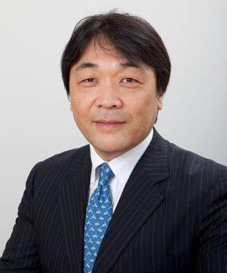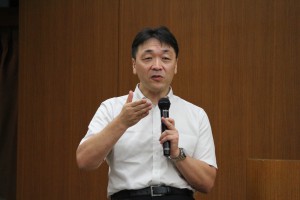This event now concluded. Report available here.
- Lecturer: Kunihiko Chris Hirabayashi (Director, UNICEF Tokyo Office)
- Date: Saturday, June 27, 2015, 1:30-3:00 pm
- Venue: Lecture Hall, International House of Japan
- Language: Only available in Japanese (without English interpretation)
- Admission: Free
 Dr. Hirabayashi was appointed as the Director of UNICEF Tokyo in 2010. Before joining UNICEF, he had worked as technical staff for the Center for International Medical Cooperation, International Medical Center of Japan, Ministry of Health, Labor and Welfare, and extended technical assistance to many countries such as Bolivia, Colombia, India, Honduras, and Vietnam for about 10 years. Prior to his current appointment, he also served as a Senior Programme Advisor to the Ministry of Public Health Afghanistan; Senior Project Officer, Chief of the Health and Nutrition Section at UNICEF Afghanistan; Chief of the Health and Nutrition Emergency Programme at UNICEF Lebanon, and Deputy Representative of UNICEF India Office. Dr. Hirabayashi earned his M.D. and Ph.D. in medicine from University of Tsukuba.
Dr. Hirabayashi was appointed as the Director of UNICEF Tokyo in 2010. Before joining UNICEF, he had worked as technical staff for the Center for International Medical Cooperation, International Medical Center of Japan, Ministry of Health, Labor and Welfare, and extended technical assistance to many countries such as Bolivia, Colombia, India, Honduras, and Vietnam for about 10 years. Prior to his current appointment, he also served as a Senior Programme Advisor to the Ministry of Public Health Afghanistan; Senior Project Officer, Chief of the Health and Nutrition Section at UNICEF Afghanistan; Chief of the Health and Nutrition Emergency Programme at UNICEF Lebanon, and Deputy Representative of UNICEF India Office. Dr. Hirabayashi earned his M.D. and Ph.D. in medicine from University of Tsukuba.
Report
Kunihiko Chris Hirabayashi has devoted much of his career to helping save human lives, first as a heart surgeon and later as a UN official. He began his presentation by comparing the deaths of two people: a Japanese man with terminal cancer whose family was at his side as he passed away peacefully and a young child in South Asia who suffered and died of hunger. “There are some maladies for which there is no cure, and others for which treatments are available,” he noted. “Why, then, must people continue to die from preventable causes, like famine?” We must take greater interest, responsibility, and action, he said, to end such tragedies.
The Economic Repercussions of Health and Education
In 2013, 6.3 million children under age five died worldwide, a marked improvement from the 11.3 million whose lives were lost in 1994. This, noted Hirabayashi, was due to growing awareness of effective life-saving measures over the past two decades, the most notable being vaccination. People dying of measles—which can be particularly fatal for children—for example, fell from 2.6 million in 1980 to just 145,000 in 2013, thanks largely to the spread of a vaccine costing less than 100 yen per dose. Other measures that have scientifically been proven to reduce under-5 mortality include the provision of vitamin A, access to safe drinking water, appropriate sanitation facilities, replenishment of electrolyte in the case of diarrhea, and effective administering of antibiotics.
 While there were 100 million children worldwide who did not attend school in 2000, that number had fallen to 58 million in 2013. “We’ve still got a long way to go,” Hirabayashi admitted, “but the fact that children in many countries are now able to attend school for at least a year or two during their primary education years is remarkable progress.” The scientific and economic impact is particularly striking in the case of girls, as data from 175 countries shows that children’s mortality rate declines when mothers have received school education—even in the absence of economic growth. Studies have shown that providing guidance for under-educated mothers of newborns and young children can push up gross domestic product by 8% over the ensuing 10 years, while enabling school-age children to continue their education for just a year can expand per capita income by 6%.
While there were 100 million children worldwide who did not attend school in 2000, that number had fallen to 58 million in 2013. “We’ve still got a long way to go,” Hirabayashi admitted, “but the fact that children in many countries are now able to attend school for at least a year or two during their primary education years is remarkable progress.” The scientific and economic impact is particularly striking in the case of girls, as data from 175 countries shows that children’s mortality rate declines when mothers have received school education—even in the absence of economic growth. Studies have shown that providing guidance for under-educated mothers of newborns and young children can push up gross domestic product by 8% over the ensuing 10 years, while enabling school-age children to continue their education for just a year can expand per capita income by 6%.
Demographic Implications
By 2030, such economic growth is expected to swell the ranks of the middle class to 4.9 billion—more than twice the current figure—primarily in Asia (+83.7%). Advances in information technology are making it easier for people to connect with one another, and “By 2030, a more fully connected society could enable networks of individuals to address many of the world’s major issues.”
Population trends, though, could present a major challenge, Hirabayashi warned. People will be living longer but the total fertility rate will decline, and regional disparities will become more pronounced. There are projections, he noted, that by 2050, one in three births will be in Africa, and by 2100 the world’s power center could shift to that continent. Whether such projections bear out will become clearer by 2030, as will be trends in the emergence of non-OECD countries as leaders in global affairs.
Seven Keywords for a Peaceful World
Climate change and the water shortage are likely to have become more acute in 2030. “Food prices may also hit the roof by 2030. There will be an empowerment of the individual by then, so each of us will have to make a greater effort to look after ourselves.” Hirabayashi listed seven keywords in this endeavor: rectitude, courage, benevolence, politeness, sincerity, cooperation, and tolerance. The first five were virtues cited by Nitobe Inazo in his seminal Bushido: The Soul of Japan, while the last two were added by Hirabayashi. “Tolerance is a trait many Japanese people have that will be extremely important in creating world without religious conflict and violence. To realize a peaceful world in 2030, he concluded, the leaders of tomorrow will need to take greater interest, responsibility, and action regarding the many pressing issues confronting the world.